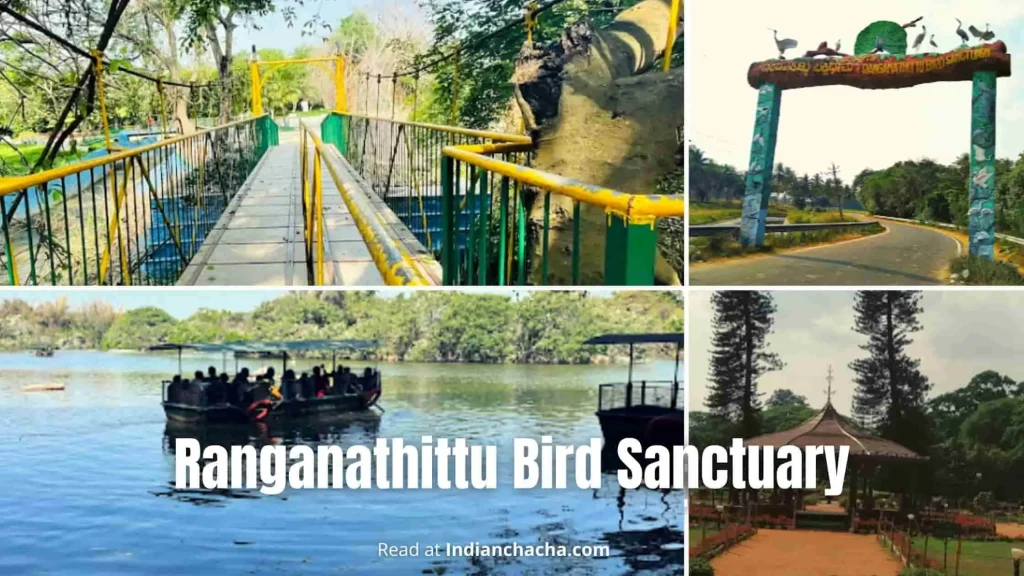Do you want to visit the Ranganathittu bird sanctuary? Why is Ranganathittu bird sanctuary famous?
I am Somraj Mondal, the Content Developer at indianchacha.com. In this blog post, I will show you complete details of the Ranganathittu bird Sanctuary.
Here, you will learn about,
- Flora and Fauna of the sanctuary
- Activities
- Accommodation Facility
- And, much more information
Let’s get started.
Table of Contents
Ranganathittu Bird Sanctuary, Karnataka Overview
Ranganathittu Bird Sanctuary (also known as Pakshi Kashi in Karnataka), is located in Srirangapatna, Manda district, Karnataka. Covering an area of 40 acres (16 ha) and comprising 6 islands on the banks of the Cauvery River, Ranganathittu Bird Sanctuary is the largest Bird Sanctuary in Karnataka for watching a large number of Bird species.
The Sanctuary is full of native plants, and colorful birds. Among 170 species of Birds, there are many Wildlife also found here such are Asian openbill stork, black-headed ibis, painted stork, stork, flying fox, common spoonbill, and many more. In addition, there are many little mammals like the common palm civet, Indian gray mongoose, monitor lizard are also found.
History of Ranganathittu Bird Sanctuary
The islands, which are a distinctive feature of the Ranganathittu Bird Sanctuary, were formed in 1648 by the Mysore king Kantirava Narasimharaja Wadia when he built a dam on the Kaveri River. At this time, One of the Popular ornithologists, Salim Ali noticed that the area of the island is full of endemic birds, and he requested the government to declare the area a Bird Sanctuary. And, Finally, the Karanataka government declared the area a Ranganathittu Bird Sanctuary in 1940.
Currently, the Forest Department of the Karnataka Government maintains the Bird Sanctuary. including the purchase of nearby private land to expand the protected area. In 2014, Forest Department expanded the 28 square kilometer area surrounding the sanctuary and declare it an eco-sensitive zone, meaning certain commercial activities cannot occur without government permission.
Flora and Fauna of the Ranganathittu Bird Sanctuary
Flora:
Ranganathittu Bird Sanctuary is covered by 6 islands. The islands are covered in broad-leaved forests which are fulfilled with dominant species of bamboo groves, Terminalia arjuna (Arjuna tree), and pandanus trees. In addition, there are many Riverine reed beds that cover the bank of the islands. Eucalyptus and acacia trees have also been planted, which may lead to the long-term eradication of native species.
Fauna:
According to the study, there are mainly 170 Bird species found in the Ranganathittu Bird Sanctuary. The Most common birds of the sanctuary are Asian openbill stork, common spoonbill, woolly-necked stork, black-headed ibis, painted stork, egret, cormorant, oriental darter, heron, and many more. This Bird Sanctuary is home large flock of streak-throated swallows. In the winter season, in mid-December, Many Migratory Birds come into the sanctuary from Siberia, Latin America, and North India.
Apart from the Birds of this Sanctuary, Ranganathittu Bird Sanctuary is also home to numerous small mammals, including bonnet macaques, colonies of flying foxes smooth-coated otters. Marsh crocodiles or marsh crocodiles are common inhabitants of river reed beds and Ranganathittu has the highest number of freshwater crocodiles in the state of Karnataka.
Things to do at Ranganathittu Bird Sanctuary
1. Boating
Boating with Friends and Family is one of the amazing funniest things to do in the Ranganathittu Bird Sanctuary in the natural environment. You can get a chance to see various birds and fauna, by boating in the Swollen Waters of the Kaveri River. You can see many migratory birds, otters, bats, and crocodiles. The Boating charges are Rs.50 for Indians and Rs.300 for foreigners.
2. Trekking
Trekking inside the Sanctuary gives you peace and an amazing vibe of Nature. Just Imagine you are surrounded by the lush green, cool wind, and the sound of chirping birds. This is exactly what you can experience here. Wander around the region and soak up the pristine natural beauty away from the bustling cities.
3. Photography
Ranganathittu Bird Sanctuary is famous for its colorful birds. There are approx 170 species of Birds. This enchanting bird sanctuary will delight every photography enthusiast. With a diverse population of both native and migratory birds, this Sanctuary is perfect for Photography.
Ranganathittu Bird Sanctuary Ticket Price, Timing
Fees:
| For Indian Adult | Rs. 50 |
| For Indian Childres | Rs. 25 |
| For Foreigner | Rs. 300 |
| Camera Charges | Rs. 500 |
Ranganathittu Bird Sanctuary Timing:
| Day | Timing |
|---|---|
| Monday | 9 AM–6 PM |
| Tuesday | 9 AM–6 PM |
| Wednesday | 9 AM–6 PM |
| Thursday | 9 AM–6 PM |
| Friday | 9 AM–6 PM |
| Saturday | 9 AM–6 PM |
| Sunday | 9 AM–6 PM |
Best Time To Visit Ranganathittu Bird Sanctuary
The best time to visit the Ranganathittu Bird Sanctuary is between September and May, especially between April and May. In the Rainy season, The area is all lush and green, but the roads are muddy and wet with rain. Summer months, though dry, allow visitors to easily spot wildlife around water sources. And, if you want to see migratory birds, the Winter season, December month is the best time for you to visit the sanctuary.
How to reach Ranganathittu Bird Sanctuary
You can reach the Ranganathittu Bird Sanctuary in 3 ways;
- By Road: There are many Private and Government Bus services available from Bangalore or Mysore city. Also, you can book a local taxi or cab to reach the Bird Sanctuary.
- By Train: Srirangapatna Railway Station is the nearest Rail station to the Ranganathittu Bird Sanctuary which is around 5 km away from the Sanctuary. After reaching the sanctuary, you need to take a cab or public transport to reach your destination.
- By Air: Mysore is the nearest Airport to the Sanctuary which is around 33 km away from the Sanctuary. After reaching the sanctuary, you need to book a Taxi to reach the location.
Location in Google Map:
Places to visit near Ranganathittu Bird Sanctuary
1. Sri Chama Rajendra Zoological Garden
Sri Chama Rajendra Zoological Garden is also known as Mysore Zoo. The area of this Zoo is 157-acre. With its diverse flora and fauna, this Zoological Garden attracts tourists from all over the world. The best part of this Garden is to provide a clean and safe environment for the animals, making it a treasure trove of wildlife and nature.
2. Sri Ranganatha Swamy Temple
Experience the serenity and religious aura at this iconic temple. Dedicated to Lord Ranganath, there is Sri Ranganatha Swamy Temple. This temple is considered to be one of the five holiest temples of Lord Vishnu.
3. Melkote
Melkote is well known Temple Town in Karnataka. The city is home to the oldest temples dating back to the 10th and 14th centuries. Cheluva Narayan Swamy Temple and Yoga Narasimha Temple are among the most popular temples in this city. During March and April Month, the annual 10-day Vairamudi festival is celebrated with great enthusiasm and fervor.
4. Mysore Palace
Mysore Palace is the epitome of royalty and architectural brilliance. To take a glimpse of the glorious past of Mysore city, you can visit the Mysore Palace.
Accommodation Facility: Stay in Ranganathittu Bird Sanctuary
Ranganathittu Bird Sanctuary has rest houses run by the forest department. Though, There are many luxury and private mid-range and luxury resort options inside the park and lodges outside the park. In addition, in Mysore city, you can also get many hotels and resorts.
Conclusion
In short, Ranganathittu Bird Sanctuary is one of the most popular destinations for Birds lovers, which is located in Karnataka, India. The sanctuary has more the 170 species of Birds. I hope you got the necessary information about Ranganathittu Wildlife Sanctuary from this article before visiting the sanctuary.
Now, I want to know from you:
Where is your current location?
Have you already visited or are you ready to explore Ranganathittu Wildlife Sanctuary?
Let me know in the comments now.
Visit Other Sanctuary:
- Purbasthali Bird Sanctuary
- Bibhutibhushan Wildlife Sanctuary
- Sandi Bird Sanctuary
- Chintamoni Kar Bird Sanctuary
- Dalma Wildlife Sanctuary
- Chapramari Wildlife Sanctuary
- Dandeli Wildlife Sanctuary
- Nandur Madhmeshwar Bird Sanctuary
- Koonthakulam Bird Sanctuary
- Chinnar Wildlife Sanctuary
- Ratapani Wildlife Sanctuary
- Tikarpada Wildlife Sanctuary
- Ballavpur Wildlife Sanctuary
- Asola Bhatti Wildlife Sanctuary
- Coringa Wildlife Sanctuary
- Pobitora Wildlife Sanctuary
- Chitrangudi Bird Sanctuary
- Bethuadahari Wildlife Sanctuary
- Soor Sarovar Bird Sanctuary
- Bhadra Wildlife Sanctuary
- Mayani Bird Sanctuary
- Point Calimere Bird Sanctuary
- Thol Lake Bird Sanctuary
- Raiganj Wildlife Sanctuary
- Patna Bird Sanctuary
- Vedanthangal Bird Sanctuary
- Ramnabagan Wildlife Sanctuary
- Mahananda Wildlife Sanctuary
- Karnala Bird Sanctuary
- Nal Sarovar Bird Sanctuary
- Senchal Wildlife Sanctuary
- Nawabganj Bird Sanctuary

Somraj Mondal is an Extensive experience in SEO and Travel, Lifestyle, and Bird Enthusiast expert of Indianchacha. A professional Blogger who loves to explore new places, and new cultures.

